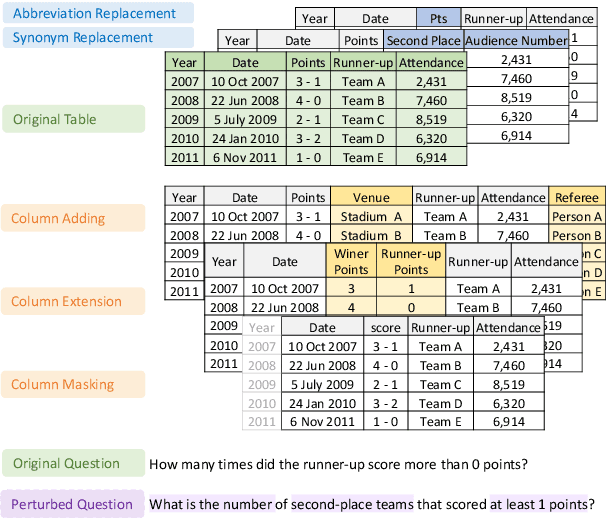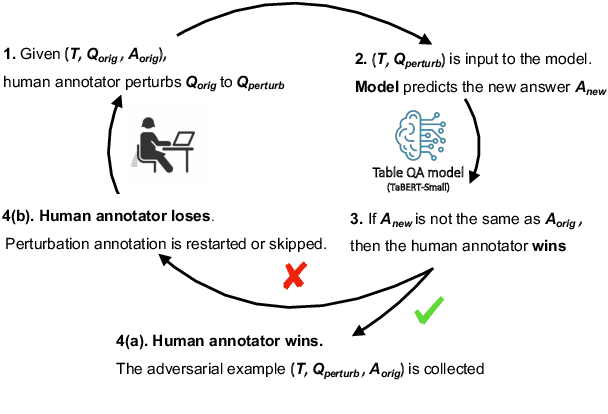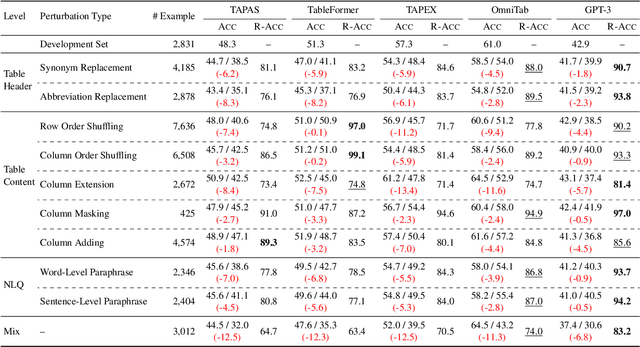Zhenting Qi
ElaLoRA: Elastic & Learnable Low-Rank Adaptation for Efficient Model Fine-Tuning
Mar 31, 2025Abstract:Low-Rank Adaptation (LoRA) has become a widely adopted technique for fine-tuning large-scale pre-trained models with minimal parameter updates. However, existing methods rely on fixed ranks or focus solely on either rank pruning or expansion, failing to adapt ranks dynamically to match the importance of different layers during training. In this work, we propose ElaLoRA, an adaptive low-rank adaptation framework that dynamically prunes and expands ranks based on gradient-derived importance scores. To the best of our knowledge, ElaLoRA is the first method that enables both rank pruning and expansion during fine-tuning. Experiments across multiple benchmarks demonstrate that ElaLoRA consistently outperforms existing PEFT methods across different parameter budgets. Furthermore, our studies validate that layers receiving higher rank allocations contribute more significantly to model performance, providing theoretical justification for our adaptive strategy. By introducing a principled and adaptive rank allocation mechanism, ElaLoRA offers a scalable and efficient fine-tuning solution, particularly suited for resource-constrained environments.
Satori: Reinforcement Learning with Chain-of-Action-Thought Enhances LLM Reasoning via Autoregressive Search
Feb 04, 2025Abstract:Large language models (LLMs) have demonstrated remarkable reasoning capabilities across diverse domains. Recent studies have shown that increasing test-time computation enhances LLMs' reasoning capabilities. This typically involves extensive sampling at inference time guided by an external LLM verifier, resulting in a two-player system. Despite external guidance, the effectiveness of this system demonstrates the potential of a single LLM to tackle complex tasks. Thus, we pose a new research problem: Can we internalize the searching capabilities to fundamentally enhance the reasoning abilities of a single LLM? This work explores an orthogonal direction focusing on post-training LLMs for autoregressive searching (i.e., an extended reasoning process with self-reflection and self-exploration of new strategies). To achieve this, we propose the Chain-of-Action-Thought (COAT) reasoning and a two-stage training paradigm: 1) a small-scale format tuning stage to internalize the COAT reasoning format and 2) a large-scale self-improvement stage leveraging reinforcement learning. Our approach results in Satori, a 7B LLM trained on open-source models and data. Extensive empirical evaluations demonstrate that Satori achieves state-of-the-art performance on mathematical reasoning benchmarks while exhibits strong generalization to out-of-domain tasks. Code, data, and models will be fully open-sourced.
Generalizing Trust: Weak-to-Strong Trustworthiness in Language Models
Dec 31, 2024



Abstract:The rapid proliferation of generative AI, especially large language models, has led to their integration into a variety of applications. A key phenomenon known as weak-to-strong generalization - where a strong model trained on a weak model's outputs surpasses the weak model in task performance - has gained significant attention. Yet, whether critical trustworthiness properties such as robustness, fairness, and privacy can generalize similarly remains an open question. In this work, we study this question by examining if a stronger model can inherit trustworthiness properties when fine-tuned on a weaker model's outputs, a process we term weak-to-strong trustworthiness generalization. To address this, we introduce two foundational training strategies: 1) Weak Trustworthiness Finetuning (Weak TFT), which leverages trustworthiness regularization during the fine-tuning of the weak model, and 2) Weak and Weak-to-Strong Trustworthiness Finetuning (Weak+WTS TFT), which extends regularization to both weak and strong models. Our experimental evaluation on real-world datasets reveals that while some trustworthiness properties, such as fairness, adversarial, and OOD robustness, show significant improvement in transfer when both models were regularized, others like privacy do not exhibit signs of weak-to-strong trustworthiness. As the first study to explore trustworthiness generalization via weak-to-strong generalization, our work provides valuable insights into the potential and limitations of weak-to-strong generalization.
Constrained Human-AI Cooperation: An Inclusive Embodied Social Intelligence Challenge
Nov 05, 2024



Abstract:We introduce Constrained Human-AI Cooperation (CHAIC), an inclusive embodied social intelligence challenge designed to test social perception and cooperation in embodied agents. In CHAIC, the goal is for an embodied agent equipped with egocentric observations to assist a human who may be operating under physical constraints -- e.g., unable to reach high places or confined to a wheelchair -- in performing common household or outdoor tasks as efficiently as possible. To achieve this, a successful helper must: (1) infer the human's intents and constraints by following the human and observing their behaviors (social perception), and (2) make a cooperative plan tailored to the human partner to solve the task as quickly as possible, working together as a team (cooperative planning). To benchmark this challenge, we create four new agents with real physical constraints and eight long-horizon tasks featuring both indoor and outdoor scenes with various constraints, emergency events, and potential risks. We benchmark planning- and learning-based baselines on the challenge and introduce a new method that leverages large language models and behavior modeling. Empirical evaluations demonstrate the effectiveness of our benchmark in enabling systematic assessment of key aspects of machine social intelligence. Our benchmark and code are publicly available at https://github.com/UMass-Foundation-Model/CHAIC.
P-FOLIO: Evaluating and Improving Logical Reasoning with Abundant Human-Written Reasoning Chains
Oct 11, 2024



Abstract:Existing methods on understanding the capabilities of LLMs in logical reasoning rely on binary entailment classification or synthetically derived rationales, which are not sufficient for proper investigation of model's capabilities. We present P-FOLIO, a human-annotated dataset consisting of diverse and complex reasoning chains for a set of realistic logical reasoning stories also written by humans. P-FOLIO is collected with an annotation protocol that facilitates humans to annotate well-structured natural language proofs for first-order logic reasoning problems in a step-by-step manner. The number of reasoning steps in P-FOLIO span from 0 to 20. We further use P-FOLIO to evaluate and improve large-language-model (LLM) reasoning capabilities. We evaluate LLM reasoning capabilities at a fine granularity via single-step inference rule classification, with more diverse inference rules of more diverse and higher levels of complexities than previous works. Given that a single model-generated reasoning chain could take a completely different path than the human-annotated one, we sample multiple reasoning chains from a model and use pass@k metrics for evaluating the quality of model-generated reasoning chains. We show that human-written reasoning chains significantly boost the logical reasoning capabilities of LLMs via many-shot prompting and fine-tuning. Furthermore, fine-tuning Llama3-7B on P-FOLIO improves the model performance by 10% or more on three other out-of-domain logical reasoning datasets. We also conduct detailed analysis to show where most powerful LLMs fall short in reasoning. We will release the dataset and code publicly.
Quantifying Generalization Complexity for Large Language Models
Oct 02, 2024Abstract:While large language models (LLMs) have shown exceptional capabilities in understanding complex queries and performing sophisticated tasks, their generalization abilities are often deeply entangled with memorization, necessitating more precise evaluation. To address this challenge, we introduce Scylla, a dynamic evaluation framework that quantitatively measures the generalization abilities of LLMs. Scylla disentangles generalization from memorization via assessing model performance on both in-distribution (ID) and out-of-distribution (OOD) data through 20 tasks across 5 levels of complexity. Through extensive experiments, we uncover a non-monotonic relationship between task complexity and the performance gap between ID and OOD data, which we term the generalization valley. Specifically, this phenomenon reveals a critical threshold - referred to as critical complexity - where reliance on non-generalizable behavior peaks, indicating the upper bound of LLMs' generalization capabilities. As model size increases, the critical complexity shifts toward higher levels of task complexity, suggesting that larger models can handle more complex reasoning tasks before over-relying on memorization. Leveraging Scylla and the concept of critical complexity, we benchmark 28LLMs including both open-sourced models such as LLaMA and Qwen families, and close-sourced models like Claude and GPT, providing a more robust evaluation and establishing a clearer understanding of LLMs' generalization capabilities.
Mutual Reasoning Makes Smaller LLMs Stronger Problem-Solvers
Aug 12, 2024Abstract:This paper introduces rStar, a self-play mutual reasoning approach that significantly improves reasoning capabilities of small language models (SLMs) without fine-tuning or superior models. rStar decouples reasoning into a self-play mutual generation-discrimination process. First, a target SLM augments the Monte Carlo Tree Search (MCTS) with a rich set of human-like reasoning actions to construct higher quality reasoning trajectories. Next, another SLM, with capabilities similar to the target SLM, acts as a discriminator to verify each trajectory generated by the target SLM. The mutually agreed reasoning trajectories are considered mutual consistent, thus are more likely to be correct. Extensive experiments across five SLMs demonstrate rStar can effectively solve diverse reasoning problems, including GSM8K, GSM-Hard, MATH, SVAMP, and StrategyQA. Remarkably, rStar boosts GSM8K accuracy from 12.51% to 63.91% for LLaMA2-7B, from 36.46% to 81.88% for Mistral-7B, from 74.53% to 91.13% for LLaMA3-8B-Instruct. Code will be available at https://github.com/zhentingqi/rStar.
Follow My Instruction and Spill the Beans: Scalable Data Extraction from Retrieval-Augmented Generation Systems
Feb 27, 2024Abstract:Retrieval-Augmented Generation (RAG) improves pre-trained models by incorporating external knowledge at test time to enable customized adaptation. We study the risk of datastore leakage in Retrieval-In-Context RAG Language Models (LMs). We show that an adversary can exploit LMs' instruction-following capabilities to easily extract text data verbatim from the datastore of RAG systems built with instruction-tuned LMs via prompt injection. The vulnerability exists for a wide range of modern LMs that span Llama2, Mistral/Mixtral, Vicuna, SOLAR, WizardLM, Qwen1.5, and Platypus2, and the exploitability exacerbates as the model size scales up. Extending our study to production RAG models GPTs, we design an attack that can cause datastore leakage with a 100% success rate on 25 randomly selected customized GPTs with at most 2 queries, and we extract text data verbatim at a rate of 41% from a book of 77,000 words and 3% from a corpus of 1,569,000 words by prompting the GPTs with only 100 queries generated by themselves.
PILLOW: Enhancing Efficient Instruction Fine-tuning via Prompt Matching
Dec 09, 2023Abstract:Instruction fine-tuning has conventionally been employed to adapt Large Language Models (LLMs) to a variety of tasks. Nonetheless, this technique often necessitates substantial computational resources, making it impractical for deployment by individuals or small-scale entities. Recently, Low-Rank Adaptation (LoRA) has become a promising alternative, offering high capabilities on par with full tuning with reduced resource overhead. However, attaining satisfactory performance through the fine-tuning of LoRA is a non-trivial challenge. In this paper, we propose PILLOW, which aims to improve LoRA's performance by a discrimination-based prompting method, leveraging LLMs' In-Context Learning ability. PILLOW incorporates a matching network that selects prompts from a user-defined prompt pool, concatenates the selected prompts with the user instruction as input, and performs inference using the LoRA-fine-tuned LLMs. Trained with Reinforcement Learning, PILLOW exhibits commensurate performance on various evaluation metrics compared with typical instruction fine-tuning methods, utilizing only consumer-grade GPU resources and exhibiting a large reduction in computational costs.
RobuT: A Systematic Study of Table QA Robustness Against Human-Annotated Adversarial Perturbations
Jun 25, 2023



Abstract:Despite significant progress having been made in question answering on tabular data (Table QA), it's unclear whether, and to what extent existing Table QA models are robust to task-specific perturbations, e.g., replacing key question entities or shuffling table columns. To systematically study the robustness of Table QA models, we propose a benchmark called RobuT, which builds upon existing Table QA datasets (WTQ, WikiSQL-Weak, and SQA) and includes human-annotated adversarial perturbations in terms of table header, table content, and question. Our results indicate that both state-of-the-art Table QA models and large language models (e.g., GPT-3) with few-shot learning falter in these adversarial sets. We propose to address this problem by using large language models to generate adversarial examples to enhance training, which significantly improves the robustness of Table QA models. Our data and code is publicly available at https://github.com/yilunzhao/RobuT.
 Add to Chrome
Add to Chrome Add to Firefox
Add to Firefox Add to Edge
Add to Edge